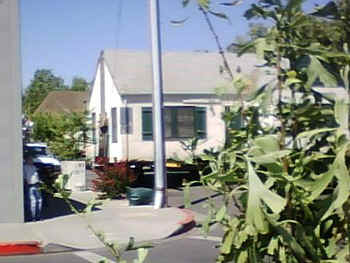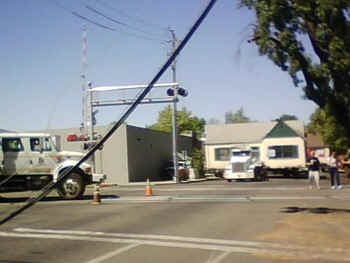I missed all the fun while I was off at Pinata Cousins Day. My boss called to let me know there there was "a bloggers dream" going on downtown. Here is the Davis Enterprise report, written by Jonathan Edwards, which is worth its own entry! (First photo by Sue Cockrell, Davis Enterprise; other photos sent from Walt's cell phone.)
 A communication snafu shut down traffic for seven hours Monday as trucks hauled two houses through downtown Davis.
A communication snafu shut down traffic for seven hours Monday as trucks hauled two houses through downtown Davis.
A nonprofit agency moved the three-bedroom, one-bath houses eight blocks along Third Street, from B Street to J Street, as part of an effort to preserve 'vintage' architecture while creating affordable housing.
The city of Davis provided the empty lot at J and Third streets, a property it purchased in August 2005. A developer, Sherman Home Company, donated the houses and $93,000, and will build townhomes on the now-empty B Street lots across from Central Park.
...
For the first part of Monday's eight-block trek, a festive caravan accompanied the houses. People danced in the streets, parents brought out their kids, a mobile pianist played 'Our house / In the middle of the street / Our house.'
Davis resident Lis Harvey brought her 2-year-old son, Penn, to watch because 'he loves construction.' This sort of thing - 'it builds community unity,' she said.
The party stalled around 10 a.m. when, between G and I streets, the houses reached the railroad tracks.

Project manager Ben Pearl had worked with AT&T, PG&E and Union Pacific to arrange to temporarily take down obstacles such as power and communication lines as well as the metal cantilevers that hold warning lights and hang over streets just before a railroad crossing.
Union Pacific, however, didn't mention that PG&E would have to be there to protect power lines as its crews unscrewed the 20-foot railroad cantilever and swung it off the road and parallel with the sidewalk, allowing the 26-foot-wide house to pass, said Steve Montgomery, the contractor in charge of the move.
'Nobody contacted us,' said Jim Kuehnau, senior field technician with PG&E. 'The first thing I even heard about this is 8:30 this morning. I said, 'Stop everything. Don't do anything till I get out there.' Ain't nobody going to get killed on my watch.
 '
'
They said Union Pacific dropped the ball, but I don't know. We'll come over and bail them out.'
Union Pacific's manager on the ground, Jason Couveau, said he didn't hear about the move until Friday, and this sort of project usually has a two-week lead time. Normally, the group who wants the obstacles removed signs a contract and all the parties get together beforehand to hash out the details. That didn't happen in this case. There was no contract or meeting.
'We have to plan out this type of thing,' Couveau said. 'You have a lot more fluidity with more planning.' As for why there was no contract or meeting ahead of time, Couveau said, 'I don't know.'
Nevertheless, the work got done, just as Couveau predicted, even though it went 'a bit slower than everyone would've liked.'
The houses cleared the street around 1:30 p.m. but the streets remained shut down till about 3 p.m., when Union Pacific's crews cleared out.

Montgomery said normally, he doesn't praise utility companies, but PG&E responded quickly. 'They were a lifesaver,' he said. 'We could've been there three more hours.'
Businesses along Third Street saw a drop in business. Five workers at Cable Car Wash sat with their arms folded looking out at Union Pacific and PG&E crews, which blocked access to their driveway.
Bob, a car washer who declined to give his last name, took it all in stride.
'It didn't go quite as quickly as they thought,' Bob said with a laugh. ' 'Just a minute' (they said).'
A couple of doors down, shoppers roamed the aisles of the SPCA Thrift store, but business was still slow for a Monday, said Katie Zane, shift leader.
But being able to watch two houses roll by was 'cool'; the staff had been ducking out all day to go and check it out, she said. It also gave workers a breather, allowing them to catch up after a busy weekend.
'It didn't affect us as much as we thought,' Zane said.
She hopes the new co-op residents will follow their brethren and patronize the thrift store heavily. 'This is going to bring a lot more business, because the co-ops have always supported us.'
Zane, who once lived in a co-op, said, 'It was really cool to see a co-op being born.'
The birth also was a death, as the two houses were uprooted from their original location. Nancy Candelo's grandfather, C.F. Dixon, built one of them in about 1930.
'I think those old houses along B Street have a certain character,' she said. 'Now you're going to get some high-rise condos in its place.'
Still, she said, 'it's better than it being torn down.'

4 comments:
traditionally a person find a spot and then they build a house on that spot. I guess they do it differently in California.
Actually I saw a house bigger than that moved a distance. a very slow process.ci
I once did a story about a plantation home that was moved 3 miles to a new location in S. Carolina. If you're interested, the story is here. They made a movie about it.
I don't know if I would want to live in a transplanted house, after all that. It happened in my town once... about twenty years ago.
::mingle::
To my knowledge, this kind of thing does not happen here in the UK. I think our planning laws would make this an impossible task!
Hubby and I watched a documentary recently about a guy who moves houses for a living. We found it absolutely fascinating! I would love to see a house in transit! That would be awesome!
:)
Annette
www.mammakerr.com
::mingle::
Post a Comment